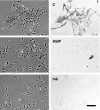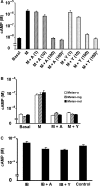Agouti protein, mahogunin, and attractin in pheomelanogenesis and melanoblast-like alteration of melanocytes: a cAMP-independent pathway
- PMID: 19493315
- PMCID: PMC2784899
- DOI: 10.1111/j.1755-148X.2009.00582.x
Agouti protein, mahogunin, and attractin in pheomelanogenesis and melanoblast-like alteration of melanocytes: a cAMP-independent pathway
Abstract
Melanocortin-1 receptor (MC1R) and its ligands, alpha-melanocyte stimulating hormone (alphaMSH) and agouti signaling protein (ASIP), regulate switching between eumelanin and pheomelanin synthesis in melanocytes. Here we investigated biological effects and signaling pathways of ASIP. Melan-a non agouti (a/a) mouse melanocytes produce mainly eumelanin, but ASIP combined with phenylthiourea and extra cysteine could induce over 200-fold increases in the pheomelanin to eumelanin ratio, and a tan-yellow color in pelletted cells. Moreover, ASIP-treated cells showed reduced proliferation and a melanoblast-like appearance, seen also in melanocyte lines from yellow (A(y)/a and Mc1r(e)/ Mc1r(e)) mice. However ASIP-YY, a C-terminal fragment of ASIP, induced neither biological nor pigmentary changes. As, like ASIP, ASIP-YY inhibited the cAMP rise induced by alphaMSH analog NDP-MSH, and reduced cAMP level without added MSH, the morphological changes and depigmentation seemed independent of cAMP signaling. Melanocytes genetically null for ASIP mediators attractin or mahogunin (Atrn(mg-3J/mg-3J) or Mgrn1(md-nc/md-nc)) also responded to both ASIP and ASIP-YY in cAMP level, while only ASIP altered their proliferation and (in part) shape. Thus, ASIP-MC1R signaling includes a cAMP-independent pathway through attractin and mahogunin, while the known cAMP-dependent component requires neither attractin nor mahogunin.
Figures







References
-
- Abdel-Malek ZA, Scott MC, Furumura N, Lamoreux ML, Ollmann M, Barsh GS, Hearing VJ. The melanocortin 1 receptor is the principal mediator of the effects of agouti signaling protein on mammalian melanocytes. J. Cell Sci. 2001;114:1019–1024. - PubMed
-
- Aberdam E, Bertolotto C, Sviderskaya EV, de Thillot V, Hemesath TJ, Fisher DE, Bennett DC, Ortonne JP, Ballotti R. Involvement of microphthalmia in the inhibition of melanocyte lineage differentiation and of melanogenesis by Agouti signal protein. J. Biol. Chem. 1998;273:19560–19565. - PubMed
-
- Barsh GS. Regulation of pigment type switching by agouti, melanocortin signaling, attractin and mahoganoid. In: Nordlund JJ, Boissy RE, Hearing VJ, King RA, Oetting WS, Ortonne JP, editors. The Pigmentary System. 2nd edn. Massachusetts: Blackwell Publishing; 2006. pp. 395–409.
-
- Bennett DC, Lamoreux ML. The color loci of mice– a genetic century. Pigment Cell Res. 2003;16:333–344. - PubMed
Publication types
MeSH terms
Substances
Grants and funding
LinkOut - more resources
Full Text Sources
Research Materials
Miscellaneous

